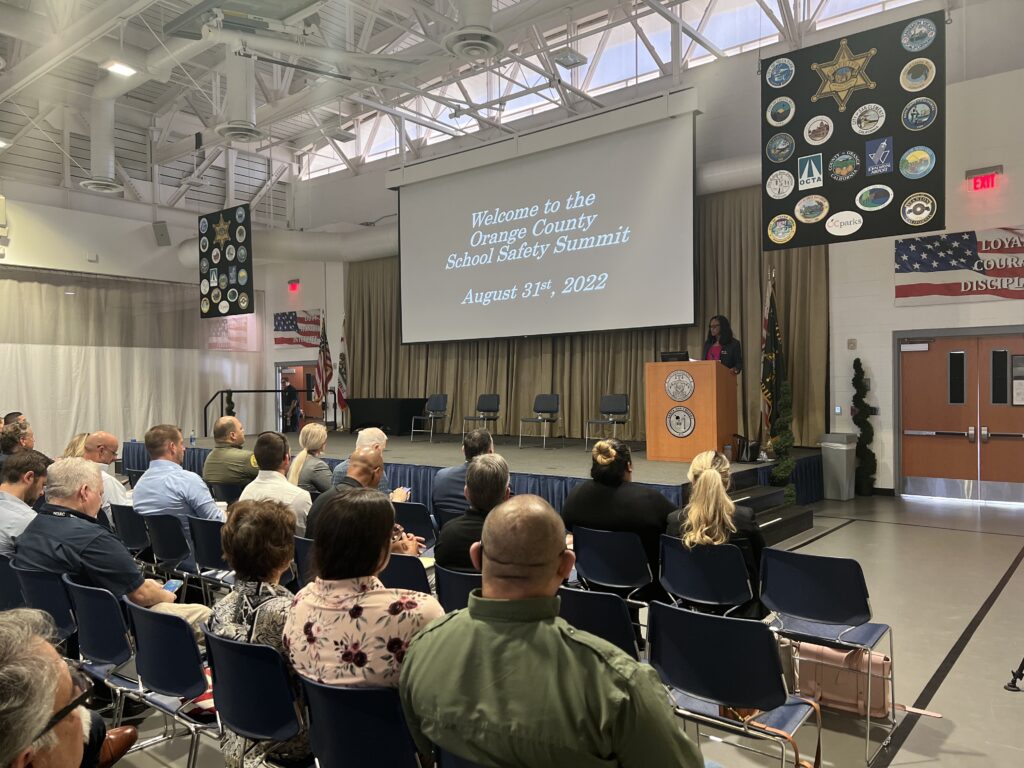School safety professionals and law enforcement leaders gathered at the Orange County Sheriff’s Regional Training Academy in Tustin on Wednesday to discuss threat assessment trainings, crisis response, truancy programs and other strategies to keep local campuses safe and secure.
Emblematic of school safety efforts throughout the region, the half-day Orange County School Safety Summit represented a unique, countywide collaboration between OCDE, the Sheriff’s Department, the District Attorney’s Office and the Probation Department.
In 2018, these same four agencies partnered to establish the Orange County School Threat Assessment Team, or OCSTAT for short. Its primary goal has been to reduce the risk of school violence by creating a process for identifying individuals whose behavior causes concern — and communicating those concerns with one another.

“Moving forward, we applaud the meaningful work that’s being done in Orange County. It’s like no other place,” OCDE Deputy Superintendent Nina Boyd told an audience of about 200 on Wednesday. “We sincerely believe that in our county, all of the right players are involved, engaged and doing the work that is necessary.”
Also delivering introductory remarks at the summit were Orange County Sheriff Don Barnes, District Attorney Todd Spitzer and Chief Probation Officer Daniel C. Hernandez. Attendees included school resource officers, social workers, counselors and psychologists.
On the eve of National Preparedness Month, OCSTAT was a featured topic, as were other proactive measures embraced by Orange County, such as the Orange County School Mobile Assessment and Resource Team, or SMART, which is designed to respond and resolve safety concerns before they escalate.
Another collaboration highlighted was the Orange County Intelligence Assessment Center. OCIAC is an intelligence-sharing network or “fusion center” that leverages the resources of the Sheriff’s Department, the FBI and the U.S. Department of Homeland Security to detect, investigate and prevent criminal and terrorist activity.
“Today’s conference is about keeping us on the same page so we can continue the success that we’ve had in Orange County,” Spitzer said.
“The end goal for us,” said Sheriff Barnes, “is to make sure that we are highlighting the efforts of every best practice that happens nationally … to create a safe environment for our students and our teachers to teach.”
A race with no finish line
In July, OCDE and the Sheriff’s Department also teamed up for the 13th annual Safe Schools Conference in Garden Grove.
Presented by former California Secretary of Education Dave Long through his firm, Dave Long & Associates, that three-day event brought together more than 500 educators and law enforcement representatives to share information on campus violence, bullying, social media trends, human trafficking, gangs, substance abuse and other critical issues.
Yet school safety begins at the local level. In California, every public school must develop and annually update a plan that addresses campus risks, outlines preparations for emergencies and contributes to safe and secure learning environments for students and staff. These reports, known as Comprehensive School Safety Plans, are reinforced regularly through site-level drills, including evacuations and shelter-in-place exercises.
“For campuses and districts across Orange County, school safety is a race that has no finish line,” Boyd said.
Support for schools, districts
School safety strategies generally vary by campus and are ultimately up to each district’s school board and superintendent, in partnership with parents, teachers, students, staff, communities and local law enforcement.
OCDE supports their efforts throughout the year with trainings and workshops that cover an array of topics, including school safety plans, earthquake preparedness, behavioral threat assessments, resilience strategies and active-shooter behavioral indicators.
At the same time, OCDE promotes positive school climates through initiatives like the Multi-Tiered System of Support framework. MTSS aligns academic, behavioral, social-emotional and mental health supports while offering differentiated interventions to meet each student’s needs. In 2016, OCDE was selected by the California Department of Education as the lead agency to help scale up MTSS statewide.
When critical incidents do impact schools, OCDE’s Crisis Response Network deploys psychologists, nurses, social workers and other personnel to support students and staff during and after emergencies. The team also provides training to schools, youth service providers, parents and students.
“You can’t talk about school safety without talking about mental health,” said Mayu Iwatani, OCDE’s manager of Mental Health and Wellness Care Coordination. “They are directly connected.”
